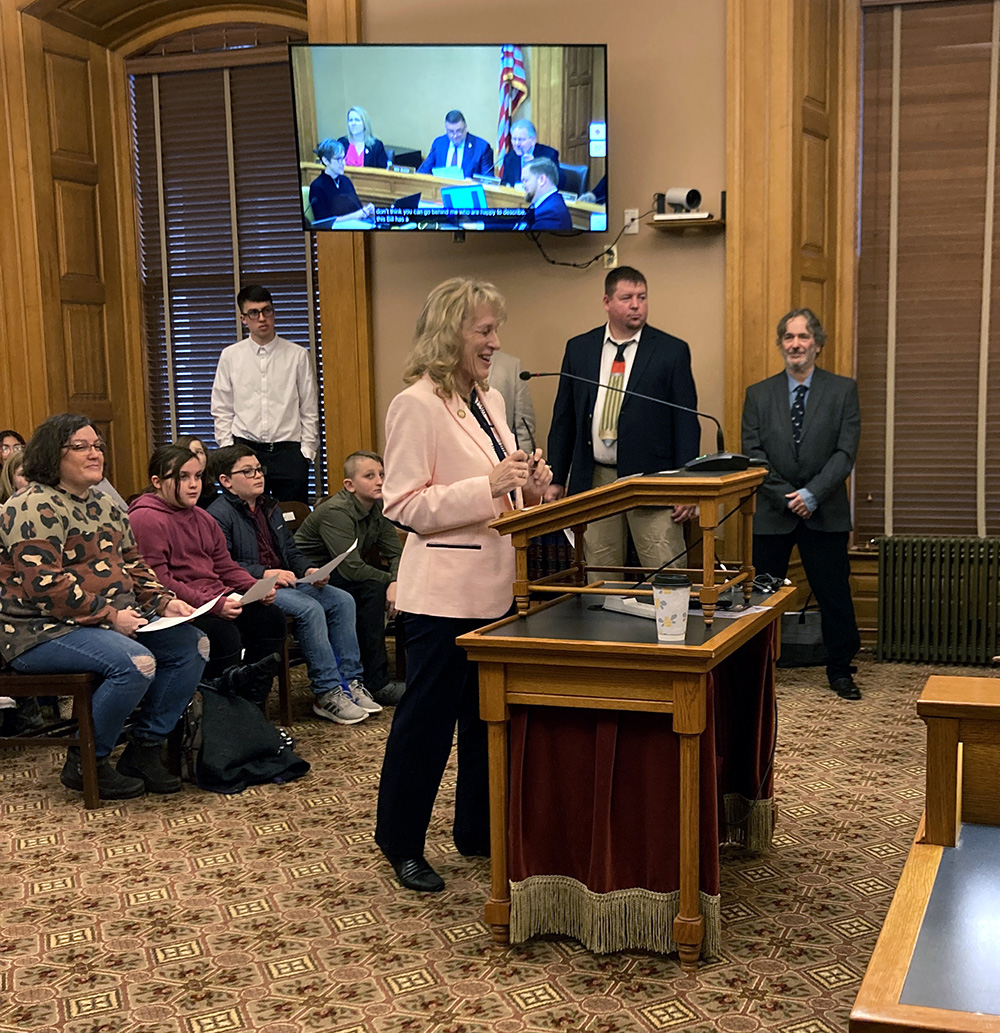Kansas designates Silvisaurus condrayi the official state land fossil

LAWRENCE — The only dinosaur known to have lived in what is now Kansas, Silvisaurus condrayi, was designated the official state land fossil of Kansas, thanks in part to a Kansas rancher and a Goddard schoolteacher and his sixth-grade students.

Teacher Joel Condray, his students from Challenger Intermediate School in Goddard as well as David Burnham, University of Kansas fossil preparator, provided testimony for the bill, SB-3. The bill was sponsored by State Sen. Elaine Bowers, R-Concordia, and signed by into law by Kansas Gov. Laura Kelly on April 7.
Condray is the grandson of Warren Condray, a Kansas rancher who found the fossil skeleton on his Ottawa County land in 1955 and donated it to the KU Natural History Museum’s vertebrate paleontology collection. In 1960, the fossil was described as a new species of dinosaur by KU paleontology researcher Theodore Eaton and named Silvisaurus condrayi, in honor of the Kansas rancher.
The only known skeletal specimen of Silvisaurus to date is housed at the KU Natural History Museum, a part of the KU Biodiversity Institute, which studies past and present biological diversity. The dinosaur’s fossil remains include the skull, lower jaw, backbone, ribs, limb bones, armor-like plates and a large shoulder spike, and they have been studied by researchers around the globe. Several years ago, new technologies emerged that helped KU paleontologists obtain more of the specimen from the rock in which it was embedded, and a new museum display was created for it in 2018. The exhibition can be seen at the museum, along with a large scientific illustration depicting a Silvisaurus walking.
“We owe a debt of gratitude to Warren Condray for bringing his discovery to our attention, and all Kansans can be proud that this rare find is unique to our state,” Burnham said.
Silvisaurus is a species of ankylosaur, an armored dinosaur, which lived during the Cretaceous period 145.5-65.5 million years ago. At the time, Kansas was partially covered by the Western Interior Seaway; however, Silvisaurus lived in a forested area, indicated by an abundance of fossil leaves that were discovered with its skeletal remains. These leaf fossils inspired Eaton to name the dinosaur Silvisaurus, which means “woodland lizard.” To date, it is the only land-dwelling dinosaur known to have lived in the area. Silvisaurus stood 3 feet tall and was about 12 feet long. Its protective armor-like plates and spikes indicate that it may have had predators, though none have been found in Kansas so far. While other dinosaurs have been found in the state, they are from deposits that were under the sea during the Cretaceous period. Because they were discovered in areas that were far from land at that time, they presumably washed into the area from other regions.
Condray’s students worked together to research the history of the fossil, visit lawmakers and provide testimony in support of the bill. In early March they visited the museum to see the fossil and meet with the museum’s vertebrate paleontology staff.
"It has been an amazing experience both working with my students to be a part of history, but also to help carry on my grandfather's incredible story and legacy. The students and I share tremendous gratitude for the opportunity," Condray said.
Megan Sims, KU vertebrate paleontology collection manager, thanked the Condray family and noted the significance of their generosity.
“We are very thankful that in 1955, Warren Condray wanted to work closely with the University of Kansas and allowed this unique and important specimen to be available to the public in perpetuity. Those connections are sometimes rare. We’re also thankful that Joel and his family have remained interested in the specimen and have taken an active role in advocating for the dinosaur’s state fossil designation.”
Silvisaurus is on view in the museum’s third-floor fossil galleries, where the official state flying fossil of Kansas, Pteranodon, can also be viewed. The official state marine fossil of Kansas, Tylosaurus proriger, a 45-foot-long mosasaur, is on exhibit in the museum’s lobby. The museum is open to the public Tuesday through Sunday.
Top image: Silvisaurus exhibit at the KU Natural History Museum.
Right image: State Sen. Elaine Bowers, sponsor of SB3. In back, center, schoolteacher Joel Condray; at right, David Burnham, KU fossil preparator. Credit: Megan Sims, KU Biodiversity Institute.